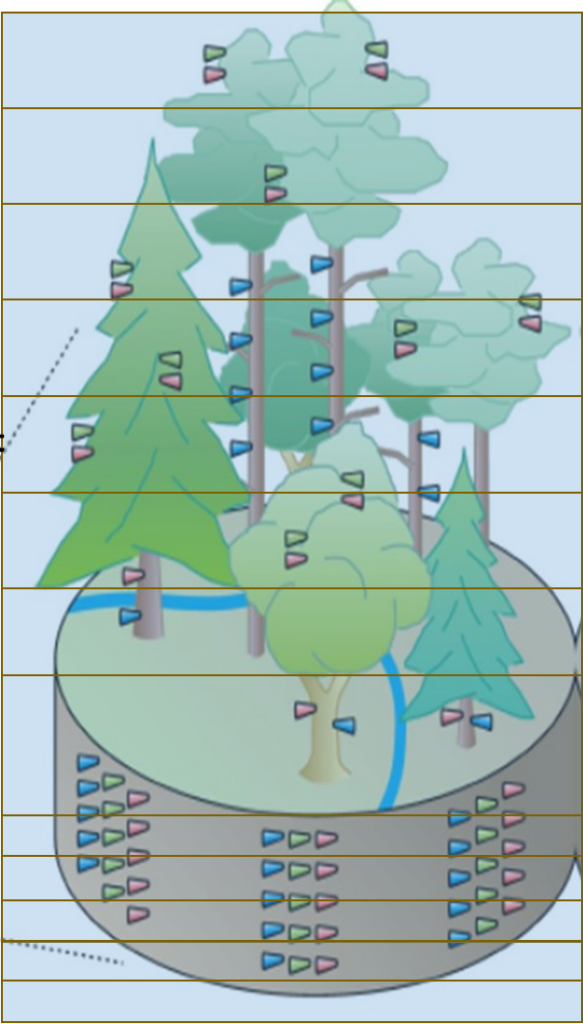Research
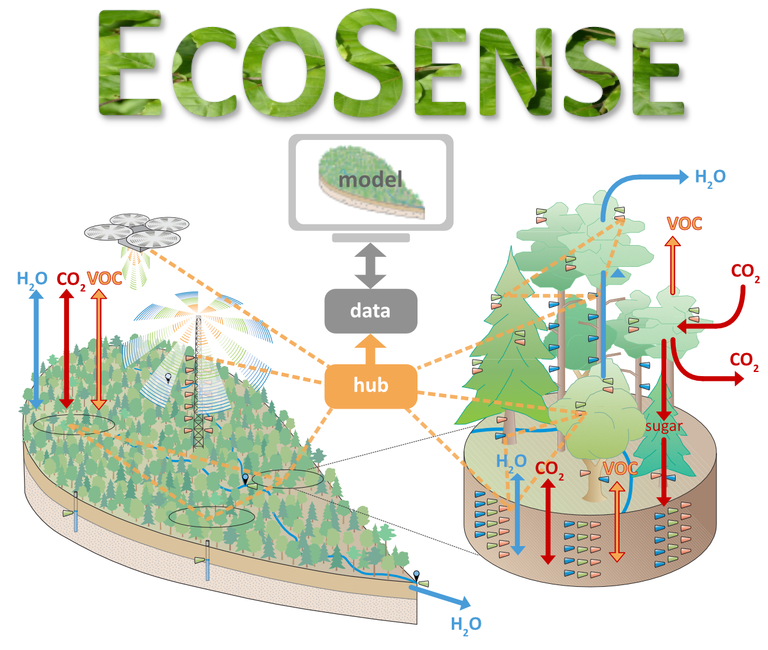
Global climate change threatens ecosystem functioning worldwide. Forest ecosystems are particularly important for carbon sequestration. However, recurrent stresses, such as heat waves, floods, and droughts, increasingly endanger even central European forests, with potentially cascading effects on their carbon sink capacity, drought resilience, and sustainability. Knowledge on the impact on the multitude of processes driving soil-plant-atmosphere interactions within these complex systems is widely lacking and uncertainty about future changes extremely high.
Our interdisciplinary research project ECOSENSE will investigate all relevant scales in a next generation ecosystem research assessment. Our vision is to detect and forecast critical changes in ecosystem functioning based on the understanding of hierarchical process interaction. To do so ECOSENSE will develop, implement, and test a new versatile, distributed, cost-effective, autonomous, intelligent sensor network based on novel microsensors tailored to the specific needs in remote and harsh forest environments. Our novel ECOSENSE Toolkit, tested and validated in controlled climate extreme experiments, and our ECOSENSE Forest, will open new horizons for rapid assessment in vast and remote ecosystems.
Research Areas
Research Area A – Water, carbon and volatile organic compound (VOC) fluxes along the different ecosystem compartments and across scales
Area A will assess key plant, soil and ecosystem processes such as photosynthesis, respiration, ecohydrological H2O fluxes, and soil-plant-atmosphere interactions. We will measure pools and fluxes of H2O, CO2 and volatile organic compounds (VOC) in mixed and pure beech and spruce stands. Installation of a novel tailored sensor network covering different scales, from soil, trees, canopy up to the atmosphere will assess the significance of spatio-temporal heterogeneity in ecosystem fluxes and stress impacts.
Spokesperson: Prof. Dr. Jürgen Wöllenstein
A1 Multifunctional and energy-autonomous soil probes for measuring carbo fluxes in the tree root environment
A1.1 Tracing soil ecological processes of CO2-fluxes
We will assess the spatio-temporal heterogeneity in soil fluxes and microclimatic/edaphic conditions to evaluate the importance of rhizosphere and microbial sources, and identify hot spots and hot moments in microbial and tree root respiration and their interactions.
PIs: Prof. Dr. Friederike Lang and PD Dr. Helmer Schack-Kirchner
A1.2 Multifunctional and energy-autonomous soil probe systems
We will develop novel soil probes measuring CO2 and temperature, which can be installed with high spatial coverage in a measuring grid. They will be energy-autonomous through thermo-electric and solar energy harvesting and thus perfectly fulfil a “deploy-and forget” strategy.
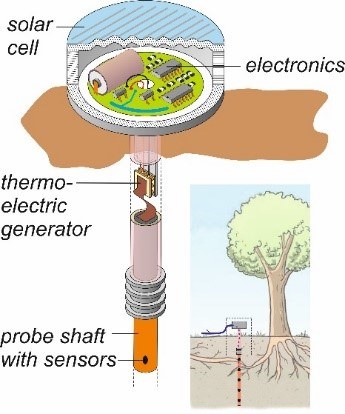
A2 Linking carbon and water fluxes in trees to the soil and atmosphere using in-situ NMR and ecohydrological sensor cluster
A2.1 Ecohydrological fluxes and processes within a mixed forest ecosystem
We will address ecohydrological fluxes and processes in heterogeneous forest patches investigating dynamics and spatial patterns in root water uptake, tree sap flow and phloem carbon isotopes, its feedbacks on spatio-temporal soil moisture variability and heterogeneity, and how this, in turn, affects tree water use efficiency and phloem sugar transport. We aim to trace water and carbon fluxes in trees and sharpen our picture of biotic controls.
PIs: Prof. Dr. Markus Weiler and Prof. Dr. Christiane Werner
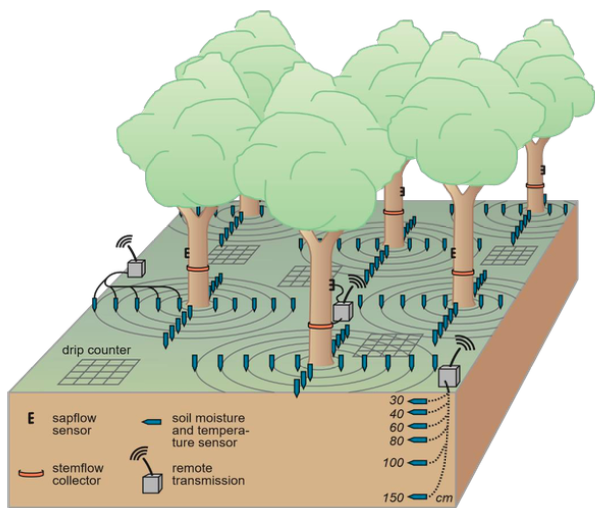
A2.2 In situ flow-MRI and NMR to measure water and phloem sap flow
We will develop a fully novel methodology through compact Magnetic Resonance Imaging (MRI) / Nuclear Magnetic Resonance (NMR) sensors based on permanent magnets attached to small‑sized branches. They will allow for in situ imaging of the H2O fluxes without interfering with the branch, and NMR analysis of xylem and phloem sap flows. Continuous in situ phloem sap NMR measurements will allow a new dimension of quantifying integrated carbon transport in trees.
PIs: Prof. Dr. Jan Korvink and Dr. Mazin Jouda
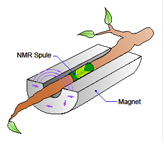
A3 An autonomous, multi-cuvettes laser-spectrometer system to study leaf photosynthetic isotope discrimination, CO2 exchange and volatile organic compound (VOC) emissions
A3.1 Spatial and temporal resolution of leaf 13CO2 and VOC fluxes
We will capture spatial and temporal dynamics in leaf gas exchange within and among tree crowns in a mixed forest. Environmental impact can be identified by 13C-isotope discrimination during photosynthesis, reflecting changes water use efficiency. Volatile organic compound (VOC) emissions are further sensitive tracers of abiotic and biotic stress, which can reveal hot spots and hot moments of these key fluxes.
PIs: Prof. Dr. Christiane Werner und Dr. Simon Haberstroh
A3.2 Development of miniaturized leaf cuvettes and compact laser spectrometer for 13CO2 isotopes
Micro gas cuvettes will be developed and deployed in large numbers to monitor the 3D-variability of 13CO2 isotope discrimination within the canopy. Equipped with an integrated open-close mechanism, they will be connected to multiple small, low-cost carbon isotope laser spectrometers, which will also measure leaf H2O fluxes. As the laser spectrometers cannot be miniaturized to a similar extent as the leaf cuvettes, they will be placed at a central position and connected by tubing.
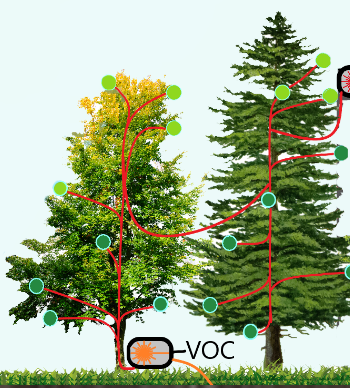
A4 Process-based ecosystem-atmosphere exchange of CO2, H2O and volatile organic compounds (VOCs)
A4.1 Ecosystem-level responses and feedbacks in ecosystem-atmosphere exchange of CO2, H2O and VOCs in a heterogeneous forest ecosystem
To bridge the gap between the relatively small scale of an individual tree, and a forest stand, A4.1 will assess ecosystem-atmosphere exchange by three towers for eddy covariance measurements of H2O, CO2 and its isoflux (13CO2), to separate fluxes into components (ecosystem respiration and gross primary production) at an integrated scale. Further VOC uptake and release by our forests will be measured, linking to important ecosystem functions, which are strongly sensitive to environmental changes.
PIs: Prof. Dr. Andreas Christen and PD DR. Jürgen Kreuzwieser
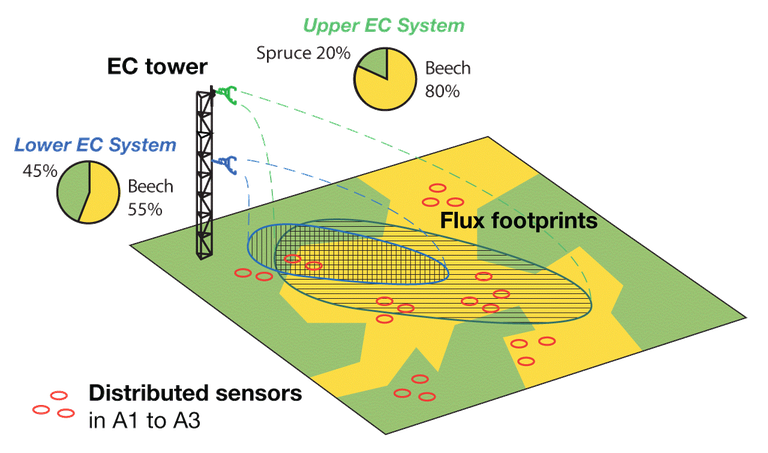
A4.2 Development of a interband cascade laser-based measurement system for studying ecosystem-atmosphere exchange of VOCs
Here, we will develop, for the first time, an optical spectroscopic sensing technology, to measure VOCs using tuneable laser absorption spectroscopy (TLAS), i.e., concentration gradients along the tower (A4.1) and connected to single-leaf cuvettes, as developed in A3.2.

Research Area B – Active chlorophyll fluorescence measurements as a sensitive stress parameter addressing the relevance of microclimatic heterogeneity
Area B will use chlorophyll fluorescence (ChlF) as a sensitive parameter to trace effects on environmental changes and biotic and abiotic stresses on the photosynthetic efficiency, ranging from leaf-based networks up to canopy and forest stand. We will identify hot spots and hot moments of stress impact in the heterogeneous forest canopies.
Spokesperson: Prof. Dr. Teja Kattenborn
B1 Wireless, energy-autonomous chlorophyll fluorescence (ChlF) measurement in tree canopies using flexible, multifunctional and highly integrated microsensor probes
B1.1 Spatio-temporal heterogeneity of leaf chlorophyll fluorescence
We will capture the spatio-temporal heterogeneity in leaf-level chlorophyll fluorescence (ChlF), a sensitive tool of photosynthetic efficiency and plant stress. Together with microclimatic measurements we will record a novel dimension of a spatial network within and among tree canopies, to efficiently identify hot spots and hot moments of stress-induced changes of photosynthetic efficiency.
PI: Prof. Dr. Christiane Werner
B1.2 Minimally Invasive and Energy-Aware Multifunctional Leaf Sensors
We will develop novel wireless, energy-autonomous ChlF sensors, using flexible, multifunctional (microclimate), and highly integrated microsensor probes. The new leaf sensor (<1cm²) will have the highest degree of miniaturization, to ensure the least interference with leaves. These sensors will act as independent sensor nodes, due to solar energy harvesting enabling them to communicate their data wirelessly, and can be installed at in a deploy-and-forget strategy.
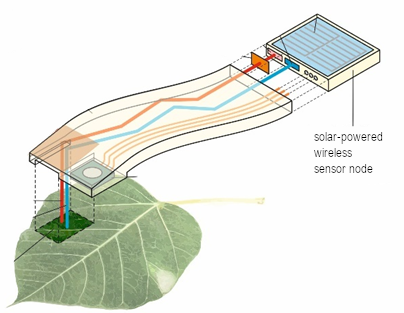
B2 Remote assessment of chlorophyll fluorescence (ChlF) as indicator for canopy vitality using UAVs with robust lightweight instrumentation
B2.1 4D-canopy-vitality using structural and active ChlF data from UAV-based remote sensing
We will use remote assessments of active ChlF via an unmanned aerial vehicle (UAV) to generate detailed repeated spatial maps to visualize and assess tree vitality, identify hot spots within the forests and transfer the sample based findings into area wide monitoring. In doing so, we will further develop the models for chlorophyll fluorescence assessment based on UAV carried remote sensing devices, calibrated against the tree leaf measurements.
Open positions: currently there are no open positions in this subproject.
PIs: Prof. Dr. Barbara Koch, Dr. Anna Göritz
B2.2 Lightweight robust versatile instrumentation for active canopy fluorescence measurements with leaf-level resolution from UAV
We will develop a strongly miniaturized, highly integrated lightweight UAV-based active ChlF measurement using LiDAR (Light detection and ranging) techniques with an efficient new scanning paradigm. It will allow for largely extended flight campaigns with high spatial resolution. Thereby, the calibration of the UAV borne data will directly profit from the leaf sensor network of B1.
Open positions: currently there are no open positions in this subproject.
PIs: Prof. Dr. Ulrike Wallrabe, Prof. Dr. Alexander Reiterer

Research Area C – Intelligent sensor network, robustness, data management, ecosystem model, and deep learning
Area C gathers cross-cutting research projects comprising data acquisition through an intelligent, energy-autonomous and robust sensor network. It assures a comprehensive and quality-assured database, process-based ecosystem modelling and deep-learning assessment.
Spokesperson: Prof. Dr. Markus Weiler
C1 Wireless, energy-autonomous and energy-aware embedded sensor systems
C1.1 Energy autonomy and energy awareness
We will perform research on specific needs for all distributed sensors (from areas A and B) creating a number of innovations for embedded autonomous sensor systems. All sensors will be equipped with ultra-low power electronics and communication capabilities to go beyond their pure sensing function, and to enable them as active and intelligent sensor nodes in our ECOSENSE network. Self-test features and energy awareness will be incorporated to improve a sensor node’s performance over time.
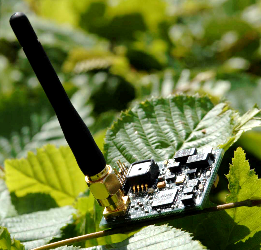
C1.2 Ultra-low power and long-range radios
Wireless communication between individual sensor nodes and central sensor hubs will be provided, by using newly established communication networks (e.g. narrow-band Internet-of-Things or NB-IoT), as well as specially tailored low-power local radio (e.g. LoRa). The energy supply of such widely distributed sensor nodes has to happen either via energy harvesting from thermal, solar, or mechanical ambient energy, or via passive remote sensing approaches similar to today’s RFID technology.
PIs: Prof. Dr. Stefan J. Rupitsch and Prof. Dr. Leonhard Reindl
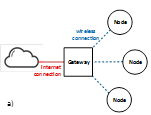
C2 Antibiofouling and Antisoiling Coatings
We will investigate how sensor nodes, such as soil probes and leaf sensors, being in direct contact to the environment can be designed to be long-living and stable by preventing fouling processes, such as the accumulation of dirt or bacterial growth. This requires tailored surface structures and antifouling coatings, whose specification strongly depends on sensor location. In soil, they are exposed to long wet phases, while in air they are exposed to large temperature and humidity variations, or simply to the accumulation of dirt.
PIs: Prof. Dr. Jürgen Rühe, Dr. Oswald Prucker, Prof. Dr. Peter Woias, Dr. Laura Comella, Prof. Dr. Ulrike Wallrabe
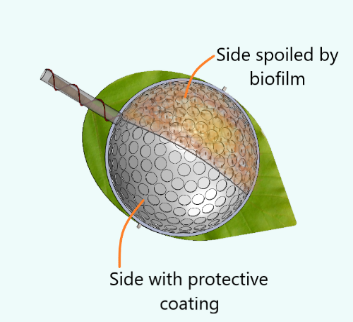
C3-INF Data management
We will generate, manage, adapt, and extend a joint database for all project data, securing homogenised formats, storage, selection, and accessibility by all groups. As ECOSENSE relies on data interoperability within and between its projects, the challenge lies in managing easy data access using existing data formats where appropriate, and creating new research data formats where necessary. We will use a central platform based on AQUARIUS for joint data storage, management of all ECOSENSE projects, and provide services for data exchange and shared data analysis tasks.
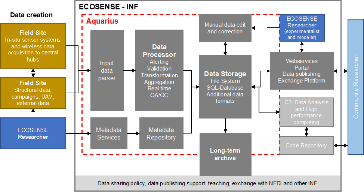
C4 Deep-learning and process-based models for simulating carbon and water fluxes across scales
C4.1 Process-based model simulations
We will carry out process-based model simulations with the objectives to 1. Improve model representations of physiological processes, water and carbon balance, and 2. Optimize spatio-temporal resolution of sensor-based monitoring. Therefore, the 2D LandscapeDNDC model will first be analyzed, extended and/or modified based on results obtained with deep learning tools (from C4.2). Afterwards, model results will be compared with different numbers and setups of sensors to improve measurement efficiency.
Open positions: currently there are no open positions in this subproject.
PIs: PD Dr. Ralf Kiese and Dr. habil. Rüdiger Grote (KIT)
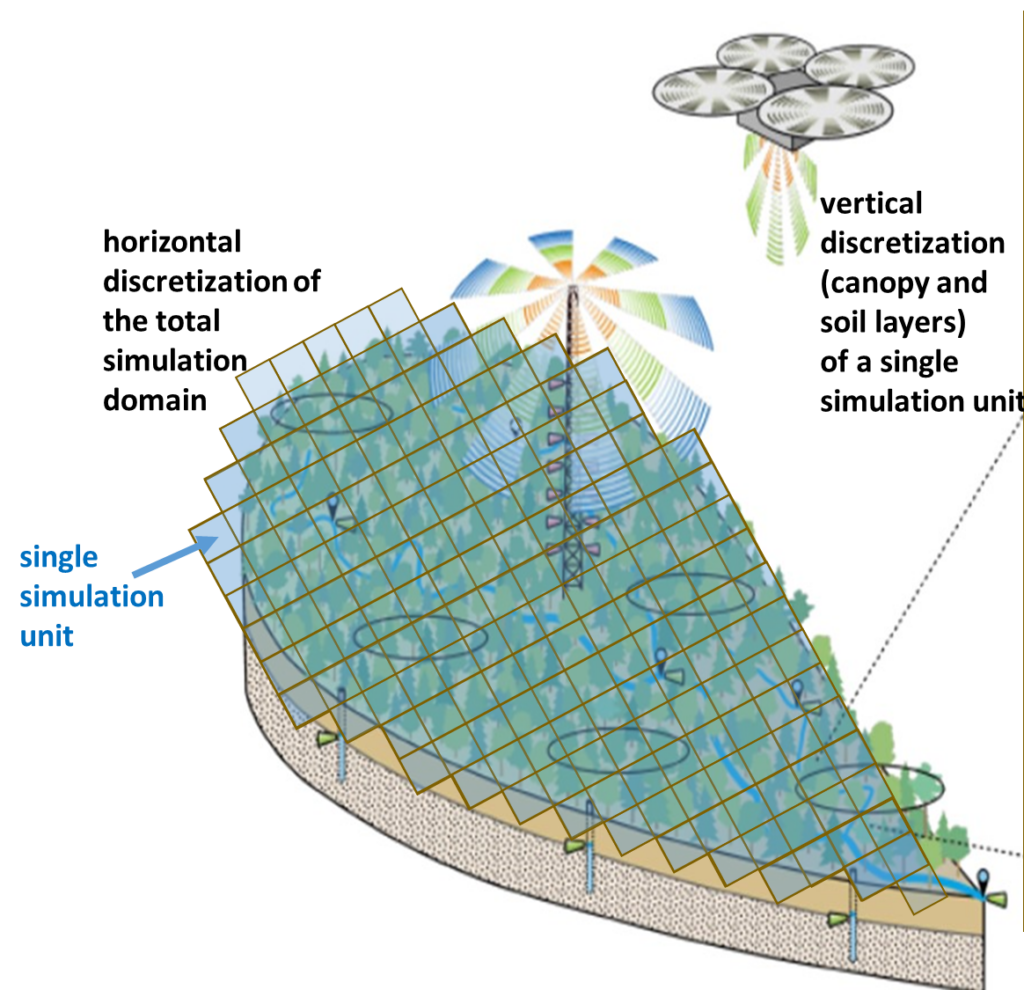
C4.2 Deep learning
Using deep-learning algorithms, the plethora of data will be efficiently evaluated to distinguish between important and redundant data. The aim is to provide sufficient spatio-temporal resolution and save sensor node energy and reduce redundant data accumulation. Thereby, deep learning and process simulations interact with the sensor network through i) data assimilation from the sensor network and ii) adjustment and optimization of the measuring design based on simulated outputs and predictions
Open positions: currently there are no open positions in this subproject.
